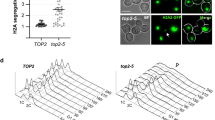Abstract
Dotted chromosomes were consistently produced in both BrdU and non-BrdU substituted Chinese hamster cells after treatment with 1.0 M Na-phosphate solution, adjusted to pH 9.0 with a supersaturating amount of NaHCO3, and at a temperature of 80–95° C. — A series of changes in chromosome morphology was produced as the temperature of the solution was progressively increased. In BrdU-treated cells, G-banding and differentially stained sister chromatids were sequentially produced prior to the appearance of dots. In non-BrdU treated cells, only G-banding was produced before dot formation. In general, the patterns of dots correspond to the G-banding patterns. — Chromatids, with uni- or bifilarly BrdU substituted DNA or with normal DNA, required differential temperatures for the production of dots. Since the temperature required for dot formation was always slightly higher than that required for producing differentially stained chromatids, this phenomenon can be used as an important indicator for determining the optimal temperature required for revealing differentially stained chromatids.
Similar content being viewed by others
References
Kato, H.: Spontaneous sister chromatid exchanges detected by a BrdU-labellmg method. Nature (Lond.) 251, 70–72 (1974)
Korenberg, J.R., Freedlender, E.F.: Giemsa technique for the detection of sister chromatid exchanges. Chromosoma (Berl.) 48, 355–360 (1974)
Latt, S.A.: Microfluorometric detection of deoxyribonucleic acid replication in human metaphase chromosomes. Proc. nat. Acad. Sci. (Wash.) 70, 3395–3399 (1973)
Latt, S.A.: Localization of sister chromatid exchanges in human chromosomes. Science 185, 74–76 (1974a)
Latt, S.A.: Sister chromatid exchanges, indices of human chromosome damage and repair: Detection by fluorescence and induction by mitomycin C. Proc. nat. Acad. Sci. (Wash.) 71, 3162–3166 (1974b)
Perry, P., Wolff, S.: New Giemsa method for the differential staining of sister chromatids. Nature (Lond.) 251, 156–158 (1974)
Wolff, S., Perry, P.: Differential Giemsa staining of sister chromatids and the study of sister chromatid exchanges without autoradiography. Chromosoma (Berl.) 48, 341–353 (1974)
Author information
Authors and Affiliations
Rights and permissions
About this article
Cite this article
Wang, H.C., Mukerji, S. Dotted chromosomes produced in sodium phosphate solution supersaturated with NaHCO3 . Chromosoma 58, 263–267 (1976). https://doi.org/10.1007/BF00292092
Received:
Accepted:
Issue Date:
DOI: https://doi.org/10.1007/BF00292092




